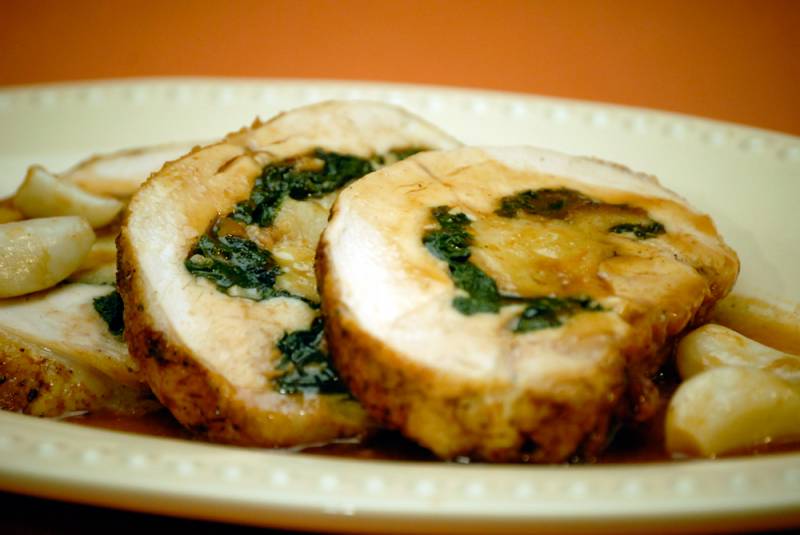SAUCE
1/3 cup water
1/2 cup dry red wine
1 celery stalk (2 ounces), peeled and cut into 1/4-inch dice (1/2 cup)
1 small onion, chopped (1/2 cup)
1 carrot (2 ounces), peeled and cut into 1/4-inch dice (1/3 cup)
1/2 teaspoon potato starch (see info below), dissolved in 1 tablespoon water
1 tablespoon dark soy sauce
1 tablespoon chopped fresh parsley
Preheat the oven to 400 degrees.
Lay the chicken skin side down on the work surface and sprinkle with the salt and pepper. Spread the cool rice or spinach mixture evenly over the chicken. If using the spinach stuffing, sprinkle the cheese and bread cubes on top of the spinach. Roll the chicken up, tie it with kitchen string, and place it in a roasting pan.
Roast the ballottine for 1 hour. Lift it from the pan and place it on a platter.
FOR THE SAUCE: Skim off and discard most of the fat from the drippings in the pan. Add the water and wine to the drippings to deglaze the pan, and heat over medium heat, stirring to loosen and melt the solidified juices.
Strain the juices into a saucepan. Add the celery, onion, and carrot and bring to a boil over high heat. Cover, reduce the heat to low, and boil gently for 5 minutes. Stir in the dissolved potato starch and soy sauce and bring the mixture back to a boil, stirring, to thicken it. Remove from the heat.
Transfer the ballottine to a cutting board and remove the string. Cut half of it into 4 or 5 slices, each about 1 inch thick. Return the uncut half of the ballottine to the serving platter and arrange the cut slices in front of it. Pour the sauce over and around the ballottine, garnish with the parsley, and serve. Cut additional slices of ballottine as needed at the table.
Red Rice Stuffing
1/2 cup Wehani rice
1 1/4 cups homemade chicken stock (see recipe below) or low-salt canned chicken broth
1/4 teaspoon salt
1/2 ounce (about 1/2 cup) dried mushrooms, such as cèpes (porcini), rinsed and broken into pieces
1/2 large leek, trimmed (leaving some green), split, washed, and sliced (1 cup)
1 onion (4 ounces), chopped (3/4 cup)
1 tablespoon olive oil
1/4 cup water
Combine the rice, stock, salt, and dried mushrooms in a large saucepan and bring to a boil, then cover, reduce the heat to low, and cook for 1 hour, or until the rice is tender. Set the rice aside in the pan, uncovered.
Meanwhile, combine the leek, onion, oil, and water in a saucepan and bring to a boil, then cover, reduce the heat, and cook at a gentle boil for 5 minutes. Remove the lid and continue to cook until all the water is gone. Add to the rice, mix well, and let cool to room temperature.
Spinach, Cheese, and Bread Stuffing
1 tablespoon olive oil
1 teaspoon finely chopped garlic
5 ounces baby spinach leaves
1/4 teaspoon salt
1/4 teaspoon freshly ground black pepper
1 cup grated Gruyère or mozzarella cheese (about 4 ounces)
1 1/2 cups cubed (1/2-inch) bread
Heat the oil in a large saucepan or skillet. Add the garlic, spinach, salt, and pepper and cook for 1 minute to soften the garlic and wilt the spinach.
Transfer to a bowl and let cool to room temperature.
POTATO STARCH
I often use a “pure starch” — generally potato starch or arrowroot — to finish a sauce and give it a bit of viscosity. If nothing else is available, you can substitute cornstarch, but it tends to make a sauce gooey and gelatinous. I prefer potato starch, which is made from steamed potatoes that are dried and ground. Potato starch is gluten-free and sometimes appears in baked goods, particularly Jewish-Passover specialties. Inexpensive and available in 1-pound packages, it can be found in the Kosher section of many supermarkets and in Asian specialty food shops (it is also used in Japanese cooking). Arrowroot, on the other hand, comes in very small containers and is very expensive.
All of these starches are used in the same way: they are diluted with a little cold liquid — water, wine, or stock — and then stirred into a hot sauce. The starch thickens the sauce on contact and then it is usually brought to a boil.
CHICKEN STOCK
Makes 3 quarts
It takes very little work to make your own stock; mostly it is a matter of being at home for the several hours it takes to cook. A flavorful money saver that is practically fat- and salt-free, homemade stock can be frozen in small quantities and used as needed.
Chicken backs and necks are available at most supermarkets. If you don’t see them, ask the butcher to set aside some for you. I also make stock from the bones of roasted chicken or turkey.
4 pounds chicken bones (necks, backs, wings, etc.), skinless or with as little skin as possible
6 quarts cold water
1 large onion (about 8 ounces), quartered
1 tablespoon herbes de Provence
12 whole cloves
4 bay leaves
1 tablespoon dark soy sauce (optional)
Combine the bones and water in a large stockpot and bring to a boil over high heat. Reduce the heat and boil gently for 30 minutes. Most of the fat and impurities will rise to the surface; skim off as much of them as you can and discard them.
Add the onion, herbes de Provence, cloves, bay leaves, and soy sauce, if using, return to a boil, and boil gently for 2 1/2 hours. Strain the stock through a fine strainer or a colander lined with dampened paper towels. Allow to cool.
Remove the surface fat and refrigerate the stock for up to 5 days, or pour into containers and freeze.
Copyright © 2011 by Jacques Pépin. Used by permission of Houghton Mifflin Harcourt. All rights reserved.
